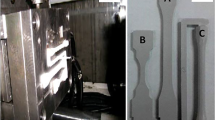Abstract
Injection molding has gained an enormous importance over the last twenty years. This is due both to the development of sophisticated products and to the efforts being generally made to the reduction of product weight specially in automobile industry. Developments aimed at creating innovative products are expected to broaden industrial implementation of their techniques. Establishment then requires the progressive development of existing mold techniques and engineering knowledge. This paper describes a successive process for molding multi component complicated products such as door trim, instrument panel and so on. Using an analytical model, the orthogonal experiment method (Taguchi method) and numerical simulation, an optimal process for simultaneous injection molding with “core-back” and “co-injection” technique is presented to produce such innovative products. Through practical tests, this process was verified in terms of applicability.
Similar content being viewed by others
Abbreviations
- δ:
-
distance of core back
- p :
-
injection pressure
- θ 1 /θ 1 :
-
melt/mould temperature
References
Johannaber, F. and Michaeli, W., “Handbuch SpritzgieBen,” Hanser München, 2004.
Stauber, R. and Vollrath, L., “Plastics in Automotive Engineering,” Hanser Gardner Publications, 2007.
Heim, H. P. and Haber, H., “Specialized Molding Techniques: Application, Design, Materials and Processing (Plastics Design Library),” William Andrew, pp. 171–228, 2003.
Crawford, R. J., “Plastic Engineering, 3rd ed.,” Butterworth-Heinemann, pp. 245–342, 1998.
Baird, D. G. and Collias, D. I., “Polymer Processing: Principles and Design,” Wiley-Interscience Publication, pp. 177–211, 1998.
Shoemaker, J., “Moldflow design guide: a resource for plastics engineers,” Hanser Gardner Publications, pp. 1–15, 2006.
Nagaoka, T., Ishiakua, U. S., Tomari, T., Hamada, H. and Takashima, S., “Effect of molding parameters on the properties of PP/PP sandwich injection moldings,” Polymer Testing, Vol. 24, No. 8, pp. 1062–1070, 2005.
Park, H. S. and Lee, H. B., “Development of Digital Laser Welding System,” International Journal of Automotive Technology, Vol. 7, No. 6, pp. 721–728, 2006.
Park, H. S., “A Knowledge-Based System for Assembly Sequence Planning,” International Journal of the Korean Society Precision Engineering, Vol. 1, No. 2, pp. 35–42, 2000.
Park, H.-S. and Choi, H.-W., “Development of a Modular Structure-based Changeable Manufacturing System with High Adaptability,” Int. J. Precis. Eng. Manuf., Vol. 9, No. 3, pp. 7–12, 2008.
Lee, H.-S. and Isayev, A. I., “Numerical Simulation of Flow-Induced Birefringence: Comparison of Injection and injection/Compression Molding,” Int. J. Precis. Eng. Manuf., Vol. 8, No. 1, pp. 66–72, 2007.
Kim, Y. S., Lee, H. K., Huang, J. C., Kong, Y. S. and Yang, G. E., “Geometrical Compensation of Injection-Molded Thin-Walled Parts in Reverse Engineering,” Int. J. Precis. Eng. Manuf., Vol. 6, No. 2, pp. 12–18, 2005.
Author information
Authors and Affiliations
Corresponding author
Rights and permissions
About this article
Cite this article
Park, HS., Anh, D.B.H. A new approach for molding multi component parts. Int. J. Precis. Eng. Manuf. 11, 291–297 (2010). https://doi.org/10.1007/s12541-010-0033-0
Received:
Accepted:
Published:
Issue Date:
DOI: https://doi.org/10.1007/s12541-010-0033-0




